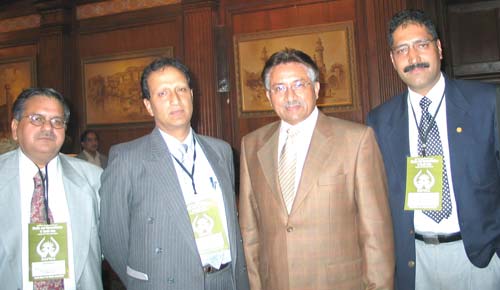by Shujaat Bukhari
Pakistan’s former President General Parvez Musharraf may be the most hated person in his country today, but in Kashmir, he has many admirers. The reason is simple. He gave a direction to the peace process between India and Pakistan and focused more on resolving the vexed Kashmir issue. Many a time, I had argument with my Pakistani friends, who see him as a dictator who, according to them, “ruined the country” by thwarting democracy. They have a reason in saying so. But I, as a Kashmiri, see him the one leader of Pakistan who did not resort to rhetoric in the course of pressing for resolving the Kashmir issue. He did burn his fingers by being the architect of a misadventure called Kargil but he had later realized that Kashmir couldn’t be wrested from India through military means. He must have taken the stock of the three wars his country fought and then his own failed plan in Kargil.
I have met General Musharraf a few times. First time I met him during the visit of Kashmiri and Indian journalists to Pakistan in December 2004 under the aegis of South Asia Free Media Association (SAFMA). The visit in itself was ground breaking and had been taken up in response to a similar visit by the first ever group of Pakistani journalists to Kashmir in November that year. That was the beginning of a process which brought a discernable change not only in the relations between India and Pakistan but also the two divided parts of Kashmir across the Line of Control. Process surely owes its existence to historic Lahore visit by then Prime Minister Atal Behari Vajpayee who signed a declaration with his counterpart Nawaz Sharif committing to take forward the peace process. Kargil certainly punctured that process, but astoundingly it was Musharraf who gave a shape to that by opening up the Pakistani space for the Confidence Building Measures to boost the understanding in both parts of Kashmir. Ceasefire along the LoC was something which tens of thousands of people living on borders have not forgotten as they could return to their homes and live peacefully after a gap of 15 years. Hundreds of people had been killed and maimed during the fighting between the two armies.
Not that General Musharraf was only a dictator who “chained Pakistanis in the Army rule”. He did some good to his people as well. Vibrant media in Pakistan, revolution in Information Technology and introducing grass root democracy to free the people from the clutches of feudal and the traditional ruling families were some high points of his rule. Leaving that aside, Musharraf’s contribution in making Kashmir a real issue between the two countries cannot be ignored so easily. He did face some resistance from the extremist groups who felt “marginalized” and “oppressed” under his regime, but he hardly relented on his agenda of taking the process of resolution forward. He was accused of sell-out, but those who opposed him on Kashmir hardly could understand that any change in the status quo was in favour of Kashmiris and to an extent Pakistan as well. Otherwise, Kashmir had remained locked in the files and confined to press release “struggle” on both sides. Lofty promises and emotional speeches had taken a heavy toll on the people. Notwithstanding the fact that it was New Delhi, which was responsible for pushing youth into armed struggle, Pakistan lent active support to it. But it could not handle it according to wishes of people, showed contempt towards Kashmiris and “hijacked” the entire thing, thus giving birth to Ikhwan culture. This proved to be nemesis of a struggle which was purely indigenous in the character.
When I asked General Musharraf in an interview as to why he reneged on everything from UN resolutions and Pakistan’s stated position on Kashmir, he shot back: “India tells the whole world we are rigid and we are not amenable to any process of resolution. I say we do not stick to anything. Let us think out of box. Come forward and we meet half way’. Musharraf’s understanding was clear. That is why he started with his 4-point formula which envisaged that Kashmir should have the same borders but people be allowed to move freely across the region; The region should have self-governance; Troops should be withdrawn from the region in a phased manner; and a joint mechanism comprising representatives from India, Pakistan and Kashmir be set up to supervise the implementation of such a roadmap for Kashmir.
This was a stepping-stone to final resolution. Both India and Pakistan had agreed to implement it and 2007 was the year when the process of implementation was to begin. But as the resolution of Kashmir has always been jinxed, he fired the judges, faced the wrath of people and was forced to leave. Except for one leader in the separatist camp, he had taken every other leader on board and they even support it today. Hina Rabbani Khar, the former Foreign Minister of Pakistan, too disclosed that the solution process could revolve round this framework only but the only problem was with the name. I am sure Nawaz Sharif cannot give a better solution and will have to be content with this set of proposals. But his challenge will be whether he can realize even this much, not to talk of something which is based on UN Resolutions.
















What to say about local leaders who do not like Musharafs 4 point programme perhaps worried about their own markets,Most embarrassing for me was to celebrate Musharafs exit as President by few elements who made announcement in a huge gathering about Mushs, exit as if kashmiris were freed from india. How tasty we are ? No blood shed any more as we have already lost around 100 thousand innocents and our leaders are issuing daily press statements with out which their food can’t be digested @Shujahat Bukhari